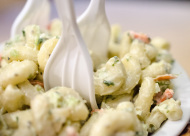Israeli salad
- 15 ingredients
- Servings per recipe: 2
- Serving size: 456 g
Preparation & details:
Source: David Lebovitz
110 recipes on HappyForks
Amount per 100 g
- Energy (calories): 132 kcal 6%
- Protein: 2.95 g 5%
- Fat: 11.78 g Why gray? Help 24%
- Carbohydrates: 5.75 g 2%
Calorie breakdown
Help
- Protein: 8% 10 kcal
- Fat: 76% 101 kcal
- Carbohydrates: 16% 21 kcal
Omega 6 : Omega 3
Help
1:1 20:1 58:1
General
Energy
132 kcal
6%
Water
78.31 g
3%
Carbohydrates
Carbohydrate
5.75 g
2%
Fiber
1.5 g
6%
Sugars, total
2.68 g
Starch
0.51 g
Lipids
Total lipid (fat)
11.78 g
24%
Total polyunsaturated
3.851 g
Omega 3 (n-3)
0.064 g
4%
Omega 6 (n-6)
3.708 g
31%
Total monounsaturated
4.827 g
Total saturated
1.838 g
as low as possible
Total trans
0.002 g
as low as possible
Cholesterol
5 mg
as low as possible
Protein + aminoacids
Protein
2.95 g
5%
Tryptophan
0.028 g
9%
Threonine
0.104 g
8%
Isoleucine
0.124 g
10%
Leucine
0.208 g
8%
Lysine
0.152 g
6%
Methionine + Cystine
0.096 g
8%
Methionine
0.053 g
Cystine
0.043 g
Phenylalanine + Tyrosine
0.211 g
10%
Phenylalanine
0.112 g
Tyrosine
0.099 g
Valine
0.152 g
10%
Vitamins
Vitamin C
13.8 mg
18%
Folate, total
25 µg
Folate, DFE
25 µg DFE
6%
Vitamin B-1 (Thiamin)
0.074 mg
7%
Vitamin B-2 (Riboflavin)
0.096 mg
9%
Vitamin B-3 (Niacin)
0.762 mg
5%
Vitamin B-5 (Pantothenic acid)
0.255 mg
5%
Vitamin B-6
0.093 mg
7%
Vitamin B-12 (Cobalamin)
0.09 µg
4%
Vitamin A
1512 IU
65%
Vitamin E
1.67 mg
11%
Vitamin D
1 IU
0%
Vitamin K
45.7 µg
51%
Isoflavones, total
0 mg
Minerals
Calcium, Ca
49 mg
5%
Magnesium, Mg
38 mg
12%
Phosphorus, P
99 mg
14%
Iron, Fe
1 mg
6%
Potassium, K
246 mg
5%
Sodium, Na
128 mg
9%
Zinc, Zn
0.97 mg
12%
Copper, Cu
0.181 mg
20%
Selenium, Se
1.1 µg
2%
Manganese, Mn
0.979 mg
54%
Similar recipes
- Protein: 10%
- Fat: 35%
- Carbs: 56%
Carrot soup with tahini and crisped chickpeas
- 83 kcal
- 22 ingredients
Ingredients
| Ingredient description | Matched product |
|---|---|
| 1 ripe tomato | Tomatoes · red · ripe · raw · year round average - 1 medium whole (2-3/5" dia) |
| 1 medium cucumber, or 3 small ones | Cucumber · with peel · raw - 1 cucumber (8-1/4") |
| 1 medium carrot, peeled | Carrots · raw - 1 medium |
| 2-3 tablespoons finely chopped red onion | Onions · raw - 2.5 tbsp chopped |
| 5 red globe radishes | Radishes · raw - 5 medium (3/4" to 1" dia) |
| half a small beet, peeled | Beets · raw - 0.5 beet (2" dia) |
| half a small kohlrabi, peeled | Kohlrabi · raw - 80 g |
| large handful of arugula | Arugula · raw - 15 leaf |
| 1/4 cup finely chopped flat-leaf parsley or cilantro | Parsley · fresh - 0.25 cup chopped |
| 2/3 cup mixed nuts and seeds (such as walnuts, sliced almonds, pine nuts, pumpkin and/or sunflower seeds – coarsely chopped) | Nuts · pine nuts · dried - 0.67 cup |
| 1/3 cup crumbled Feta or firm goat cheese | Cheese · feta - 0.33 cup, crumbled |
| 2-3 tablespoons freshly squeezed lemon juice | Lemon juice · raw - 2.5 tbsp |
| 2-3 tablespoons good quality extra virgin olive oil | Oil · olive · salad or cooking - 2.5 tbsp |
| sea salt | Salt · table - 0.25 tsp |
| freshly ground pepper | Spices · pepper · black - 0.25 tsp, ground |
Possible differences in nutritional values
All the nutritional values are calculated based on the above products from HappyForks. The precise nutritional values of your recipe may differ due to the use of some specific foods, which not always have a perfect fit in HappyForks. The ingredients used in the recipe may have also different nutritional values than those in our database.
About Nutrition Facts
- Symbol "~" means missing value.
- Percentages next to nutrients show the proportion of daily recommended intake level of nutrients for a healthy person, whose data are included in the nearby profile.
- Nutrition recommendations based on Dietary Reference Intake (DRI) developed by the Institute of Medicine, source.
Advanced mode
- RDA (Recommended Dietary Allowances) - the daily daietary intake level of a nutrient that meet the requirements of 97.5% of healthy individuals in particular age group and gender.
- AI (Adequate Intake) - recommended average daily nutrient intake assumed to be adequate based on approximation of observed mean nutrient intake by a group of healthy people, used when an RDA cannot be determined.
- UL (Tolerable upper intake levels) - the highest level of daily consumption that current data have shown to cause no side effects in humans when used indefinitely without medical supervision.





